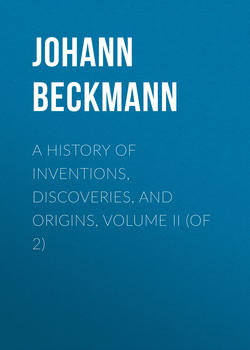Читать книгу A History of Inventions, Discoveries, and Origins, Volume II (of 2) - Johann Beckmann - Страница 6
CAMP-MILLS
ОглавлениеUnder this appellation are understood portable or moveable mills, which can be used, particularly in the time of war, when there are neither wind- nor water-mills in the neighbourhood, and which on that account formerly accompanied armies in the same manner as camp-ovens and camp-forges. Some of these mills have stones for grinding the corn, and others are constructed with a notched roller like those of our coffee-mills. Some of them also are so contrived that the machinery is put in motion by the revolution of the wheels of the carriage on which they are placed; and others, and perhaps the greater part of those used, are driven by horses or men, after the wheels of the carriage are sunk in the ground, or fastened in some other manner.
To the latter kind belongs that mill of which Zonca129 has given a coarse engraving, but without any description. He says it was invented by Pompeo Targone, engineer to the well-known marquis Ambrose Spinola; and he seems to place the time of the invention about the end of the sixteenth century. This mill is the same as that described by Beyer in his Theatrum Machinarum Molarium, and represented in the twenty-seventh plate of that work130. Beyer remarks that it was employed by Spinola.
The inventor, as his name shows, was an Italian, who made himself known, in particular, at the celebrated siege of Rochelle, under Louis XIII., at which he was chosen to assist, because in the year 1603, when with Spinola, who was consulted respecting the operations at Rochelle, he had helped by means of a mole to shut the harbour of Ostend during the tedious siege of that place. He was likewise in the French service, as intendant des machines du roi; but his numerous and expensive undertakings did not succeed according to his expectations131. He invented also a particular kind of gun-carriages, and a variety of warlike machines132.
Another old figure of such a mill was shown to me by Professor Meister, in Recueil de Plusieurs Machines Militaires, printed in 1620. This machine was driven by the wheels of the carriage; but whether it was ever used the author does not inform us.
Lancellotti133 ascribes this invention to the Germans, about the year 1633.
Carriages for transporting camp-forges and mill-machinery are mentioned by Leonard Fronsperger134, but he does not say whether complete mills were affixed to them.
129
Novo Teatro di Machine ed Edificii, di Vittorio Zonca. Padoua, 1621, and reprinted in 1656, fol. The greater part of the machines delineated in this scarce book are engines for raising heavy bodies; but many of them are used in various trades and manufactures, and may serve in some measure to illustrate the history of them.
130
J. M. Beyer’s Schauplatz der Mühlen-Bau-kunst. Leipzig, 1735, fol. Reprinted at Dresden, 1767.
131
All those authors who have written expressly on the fate of the Huguenots, the History of Richelieu, Louis XIII., and the siege of Rochelle, make mention of Targone.
132
Histoire de la Milice Françoise, par Daniel. Amst. 1724, i. p. 332.
133
L’Hoggidi, overo gl’Ingegni non inferiori a’ passati. Ven. 1636, 8vo.
134
Kriegsbuch, Frankf. 1596, fol. p. 9.
